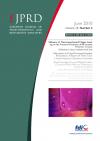European Journal of Prosthodontics and Restorative Dentistry

- Cover Date:
- June 2010
- Electronic ISSN:
- 0965-7452
- Vol:
- 18
- Issue:
- 2
Influence of Thermomechanical Fatigue Loading on the Fracture Resistance of All-ceramic Posterior Crowns
Abstract - This study evaluated the fracture resistance and the survival rate of different all-ceramic crowns invitro after thermomechanical fatigue loading in comparison to porcelain-fused-to-metal posterior crowns. Sixteen crowns for human mandibular first molars were made of each of the following: Cercon, IPS-Empress 2, In-Ceram Zirconia, Procera AllZircon and porcelain-fused-to-metal. Half of the specimens of each group was thermocycled and dynamically loaded using a chewing simulator. All samples were thereafter tested for the maximum fracture resistance. The survival rates after 1-2 million cycles in the artificial mouth were 100% in all the tested crown systems. The chewing simulation and thermocycling did not significantly decrease the fracture strength of the ceramic crowns (P> 0.005). The median fracture load of Cercon, Procera AllZircon, In-Ceram Zirconia and PFM was significantly higher than IPS-Empress 2 both for loaded and non loaded groups (P< 0.005) while the difference between Cercon, Procera AllZircon, In-Ceram Zirconia and PFM was not significant (P> 0.005). All-ceramic systems showed fracture load values similar to those of porcelain-fused-to-metal molar crowns and therefore may be considered for use in clinical studies.
KEY WORDS: All-ceramics; dynamic loading; fracture resistance; thermomechanical fatigue.
- Article Price
- £15.00
- Institution Article Price
- £
- Page Start
- 50
- Page End
- 54
- Authors
- Dilek Pinar Senyilmaz, Senay Canay, Guido Heydecke, Joerg Rudolf Strub
Articles from this issue
- Title
- Pg. Start
- Pg. End
- Influence of Thermomechanical Fatigue Loading on the Fracture Resistance of All-ceramic Posterior Crowns
- 50
- 54
- The Heat Emitted from Some Qth and Led Light Curing Units in Consecutive Activations A Laboratory Assessment
- 66
- 69
- Marginal Behaviour of Self-etch Adhesive/composite and Combined Amalgam-composite Restorations
- 70
- 77
- Three-Dimensional Positional Changes of Teeth Adjacent to Posterior Edentulous Spaces in Relation to Age at Time of Tooth Loss and Elapsed Time
- 78
- 83
- Colour Stability, Opacity and Cross-Link Density of Composites Submitted to Accelerated Artificial Aging
- 89
- 93
